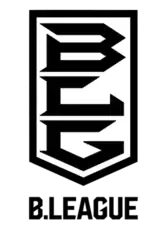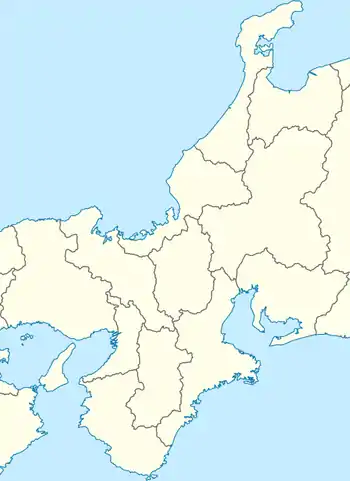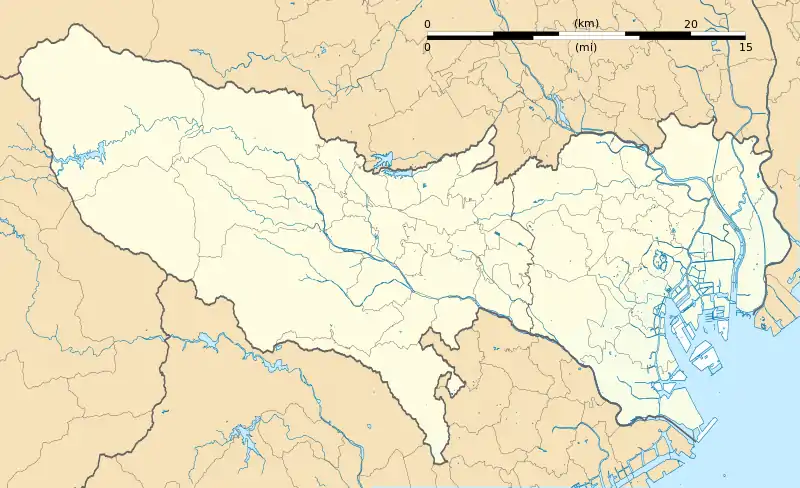B.League
The B.League[2] is a professional men's basketball league that began in Japan in September 2016.[3][4] The league is operated by the Japan Professional Basketball League and was formed as a result of a merger between the National Basketball League that was operated by the FIBA-affiliated Japan Basketball Association and the independently operated bj league. The merger had been mandated by FIBA as a condition to Japan having its membership resumed following suspension in November 2014.[5]
 | |
| Founded | April 1, 2015[1] |
|---|---|
| First season | 2016–17 |
| Country | |
| Confederation | FIBA Asia (Asia) |
| Divisions | 3 |
| Number of teams | 47 |
| Level on pyramid | 1 |
| Current champions | B1: Alvark Tokyo (2nd title) B2: Shinshu Brave Warriors (1st title) B3: Tokyo Excellence (1st title) (2018–19) |
| Most championships | B1: Alvark Tokyo (2 titles) B2: Nishinomiya Storks (1 title) B3: Rizing Zephyr Fukuoka (1 title) |
| President | Masaaki Okawa (Chairman)[1] |
| TV partners | DAZN |
| Website | BLeague.jp |
History
The Japan Basketball Association was formed in 1930 and has operated Japan's top basketball leagues under various names since 1967. Throughout the history of the association, teams have been affiliated with large corporations and players have been employed by their respective owner company rather than competing as professional basketball players. In the early 1990s soccer in Japan moved away from a similar corporate structure and launched the J.League in 1993.[6] The JBA commenced investigating the professionalization of basketball in the same year, and in 1997 lifted the ban on professional players. Despite this, the structure of the Japan Super League remained amateur in nature, with most teams remaining under the control of a corporate sponsor/owner.
In 2005 a rival bj league was launched in competition with the Super League, based on an American franchise system of professional teams. In response, the JBA re-launched the Super League as the Japan Basketball League in 2007, but there was still a mixture of professional and corporate teams in the competition. The JBL was again rebranded as the National Basketball League in 2013. Since the establishment of the bj league in 2005, both competitions rapidly expanded the number of teams, with 45 teams participating between the two competitions in 2015.[7]
FIBA, the international governing body for basketball, grew concerned with the division and disorganization of the sport within the country. After the JBA failed to comply with deadlines to commence reorganizing the domestic leagues, FIBA suspended Japan from international competitions in November 2014. A task force to investigate the reformation of the domestic leagues was formed and Saburō Kawabuchi was appointed co-chairman. In May 2015, upon FIBA's recommendation, Kawabuchi was appointed as president of the JBA.[8] The merger of the two competing leagues into the B.League was announced in June 2015[9] and the international suspension was lifted by FIBA in August.[10] Telecommunications company Softbank were named as the league's top sponsor for the inaugural season in March 2016.[11]
The 2016–17 season commenced with an inaugural match between four-time JBL/NBL champions Alvark Tokyo, who finished on top of the NBL ladder in 2015–16,[12] and four-time bj-league champions Ryukyu Golden Kings, who won the 2015–16 bj-league championship,[13] at Yoyogi National Gymnasium on 22 September 2016.[4] A full round of games involving all other teams commenced on September 24.[14][15]
Season format
The league consists of three divisions, named B1, B2, and B3. For the 2020-21 season, the first division (B1) has 20 teams and the second division (B2) has 16 teams, with a system of promotion and relegation between these two divisions. Each of the first two divisions is further divided into two conferences, East and West. The third division (B3) has eleven teams made up of de facto semi-professional teams.[16]
First Division (B1)
In the first division, each team plays a 60-game regular season schedule that consists of 36 games against teams within their own conference (4 games against each team) and 24 games against teams in the other conference (2 games against eight teams and 4 games against the remaining two teams). Eight teams qualify for the playoffs, which includes the top three teams from each conference, and the next two teams with the best records, regardless of their conference, as wild cards. The playoffs consist of quarterfinal, semifinal, and final rounds, with a best-of-three format in each round. Each round is played at the home court of the team that finished with the higher winning percentage during the season. [17]
Second Division (B2)
In the second division, the regular season will also consist of a 60-game schedule, but with 42 games against teams within their own conference (6 games against each team) and 18 games against teams in the other conference (2 games against seven teams and 4 games against the remaining team). The playoff qualification and match format is identical to the first division: Eight teams qualify for the playoffs, which includes the top three teams from each conference, and the next two teams with the best records, regardless of their conference, as wild cards. The playoffs consist of quarterfinal, semifinal, and final rounds, with a best-of-three format in each round. Each round is played at the home court of the team that finished with the higher winning percentage during the season.[17]
Promotion and relegation
The B.League typically holds promotion-relegation playoffs each year to determine which second division teams will be promoted to the first division and which first division teams will be relegated to the second division for the following season. For the 2020-21 season, it was announced that the top two teams from the second division will be automatically promoted to the first division. Other promotions and relegations will not take place.[17]
Current clubs
In the 2014–15 season, there were 12 teams in the NBL, 10 teams in the National Basketball Development League (NBDL, the NBL's second division league) and 24 teams in the bj-league. All 46 teams sought entrance to the B.League's inaugural 2016–17 season, along with the Wakayama Trians, who withdrew from the NBL in January 2015 due to financial difficulty. Ultimately, all clubs were accepted into the league except for the Trians and the Hiroshima Lightning, who were in their first season as a bj-league expansion club.[18] The allocation of the 45 teams into three divisions was announced in two phases in July[3] and August 2015.[16] In April 2016 the league announced rules regarding official team names, shortened names and abbreviations to be used by the clubs. A list of names to be used by each club in the 2016–17 season was also published.[19] Beginning in the 2020–21 season, the B.League was reformatted to only have two conferences each, East and West, in the first and second divisions.[17]
First division (20 teams)
Second division (16 teams)
Third division (11 teams)
| Team name | City, Prefecture | 2015–16 League |
|---|---|---|
| Aisin AW Areions Anjo | Anjō, Aichi | NBDL |
| Gifu Swoops | Gifu, Gifu | – |
| Iwate Big Bulls | Morioka, Iwate | bj-league |
| Kagoshima Rebnise | Kagoshima, Kagoshima | NBDL |
| Kanazawa Samuraiz | Kanazawa, Ishikawa | bj-league |
| Saitama Broncos | Tokorozawa, Saitama | bj-league |
| Tokyo Excellence | Itabashi, Tokyo | NBDL |
| Tokyo Hachioji Bee Trains | Hachioji, Tokyo | NBDL |
| Toyoda Gosei Scorpions | Kiyosu, Aichi | NBDL |
| Tryhoop Okayama | Okayama, Okayama | – |
| Veltex Shizuoka | Shizuoka, Shizuoka | – |
Referees
Team Maps
 Locations of the B.League teams  Locations of the B.League Kanto teams Locations of the B.League Tokyo teams  Locations of the B.League Kansai and Tokai teams
|
Rules
Foreign players
Each club in the first and second divisions will be allowed up to three registered foreign players, excluding one foreign-born player who has become a naturalized Japanese citizen.[21] Two foreign players will be allowed on the court. Naturalized players can play as Japanese citizens and have no limitations. Each club will be allowed one naturalized player.
In line with Japan Basketball Association regulations, foreign citizens who were either born or raised in Japan and graduated from Japanese elementary and junior high school will not be treated as a foreign player for the purpose of these rules.[17]
References
- "組織概要" [Organizational Outline] (in Japanese). Archived from the original on 19 June 2016. Retrieved 8 June 2016.
- Nagatsuka, Kaz (15 September 2015). "New pro basketball league unveils name, logo". The Japan Times. Retrieved 16 September 2015.
- "JPBLの「1部~3部階層分け発表記者会見」について" [Regarding the JPBL's "Division 1–3 Assignment Press Conference"] (in Japanese). Nishinomiya Storks. 30 July 2015. Archived from the original on 4 March 2016. Retrieved 11 August 2015.
- "B.LEAGUE開幕日・対戦カード決定のお知らせ" [B.League Opening Day Matchup Decided] (in Japanese). 24 May 2016. Archived from the original on 3 June 2016. Retrieved 1 June 2016.
- "Japan suspended by FIBA". ESPN. 26 November 2014. Retrieved 15 September 2015.
- Anthony, Scott (18 July 2010). "How Japan created a successful league". When Saturday Comes. Archived from the original on 9 August 2016. Retrieved 8 June 2016.
- Odeven, Kaz (3 October 2015). "Size of B. League will present challenges from the outset". Japan Times. Retrieved 8 June 2016.
- "Kawabuchi becomes new JBA President". 18 May 2015. Retrieved 8 June 2016.
- Nagatsuka, Kaz (19 June 2015). "FIBA on fast track to fully lift Japan Basketball Association ban in August". Japan Times. Retrieved 28 June 2016.
- Nagatsuka, Kaz (9 August 2015). "Kawabuchi welcomes end of Japan's international basketball ban". Japan Times. Retrieved 8 June 2016.
- Nagatsuka, Kaz (10 March 2016). "Softbank named top B. League partner". Japan Times. Retrieved 8 June 2016.
- Nagatsuka, Kaz (12 May 2016). "Alvark, Brex enter NBL playoffs as top teams". Japan Times. Retrieved 3 June 2016.
- Odeven, Ed (15 May 2016). "Golden Kings bring curtain down on bj-league with fourth title". Japan Times. Retrieved 3 June 2016.
- Nagatsuka, Kaz (24 May 2016). "Kings, Alvark to clash in B. League opener". Japan Times. Retrieved 3 June 2016.
- "B.LEAGUE全36クラブの開幕日・開幕対戦カード2016–17シーズンスケジュール決定のお知らせ" [Announcement that opening day matches for all 36 B.League teams and the 2016–17 season schedule have been decided] (in Japanese). 10 June 2016. Archived from the original on 13 June 2016. Retrieved 13 June 2016.
- Nagatsuka, Kaz (14 April 2020). "B. League to realign teams into two conferences for 2020-21 season". The Japan Times. Retrieved 13 September 2020.
- "Regulation". Japan Professional Basketball League. Retrieved 13 September 2020.
- "広島ライトニング、バスケの新リーグ参入への道、開かれず" [Road to new league doesn't open for Hiroshima Lightning]. Hiroshima Sport (in Japanese). 16 July 2015. Retrieved 27 September 2016.
- "Bクラブのチーム名・呼称・略称決定" [Team names, short names and abbreviations for B.League clubs decided]. 6 April 2016. Archived from the original on 19 May 2016. Retrieved 1 June 2016.
- "Arena" [Arena] (in Japanese). Retrieved 14 September 2020.
- B.League (20 June 2018). "B.LEAGUE 2018-19 SEASON 競技レギュレーション" (PDF). Retrieved 24 June 2018.
